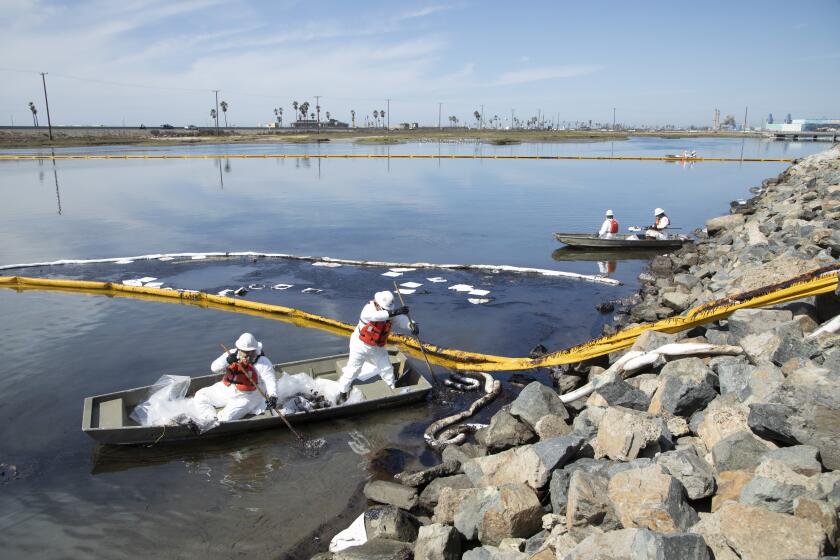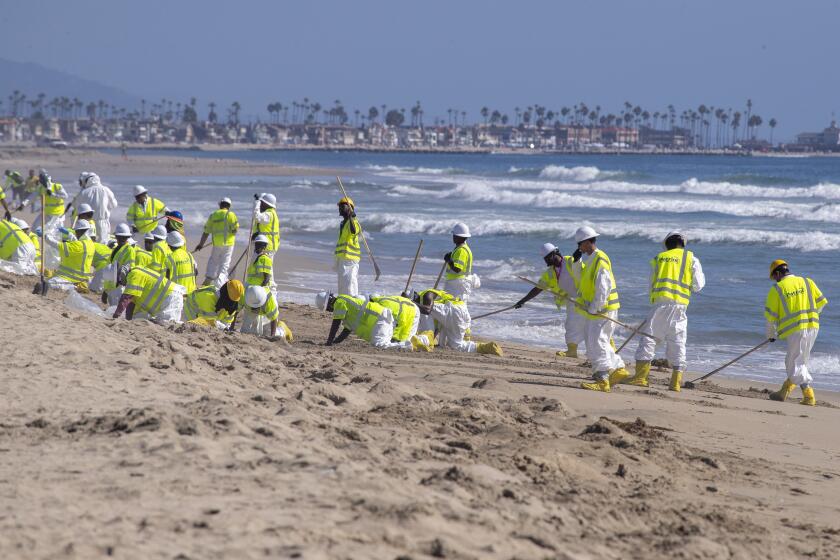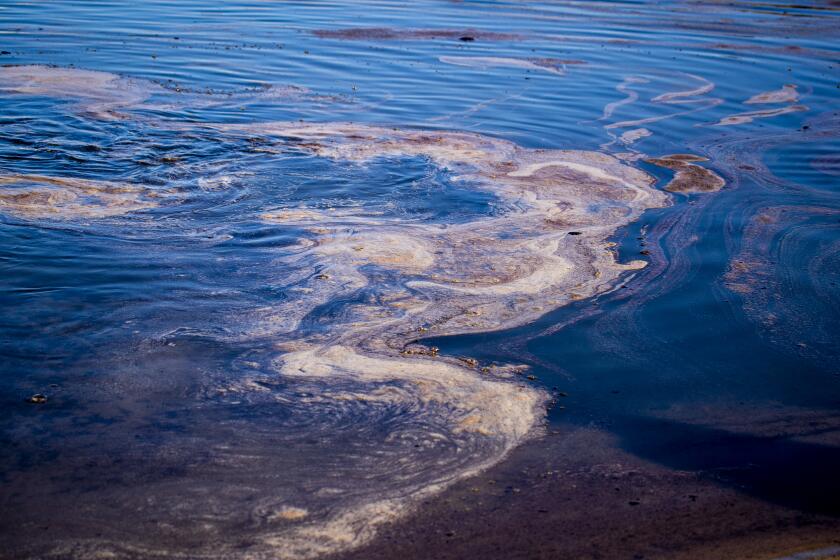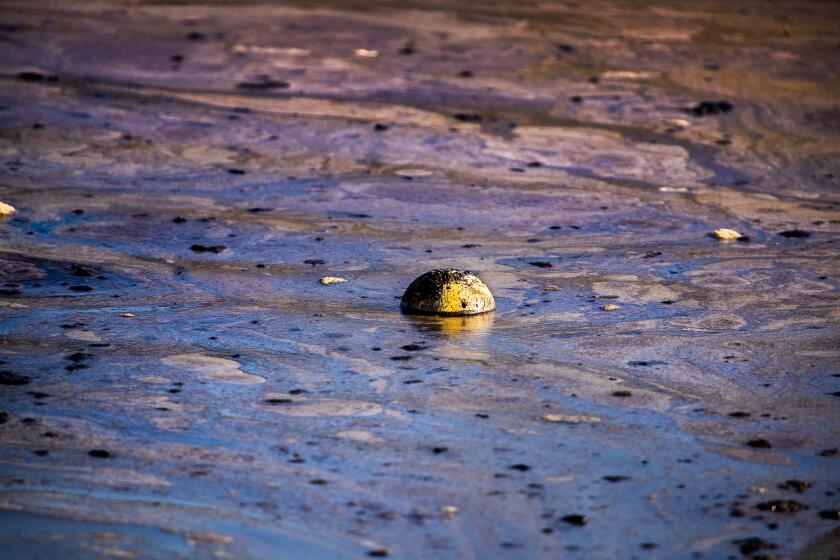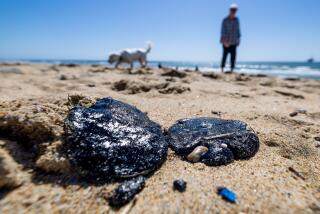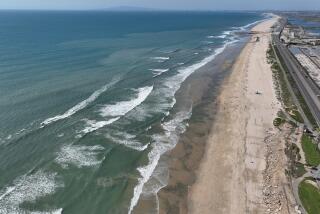Oil from massive Orange County spill expected to wash onshore for several days
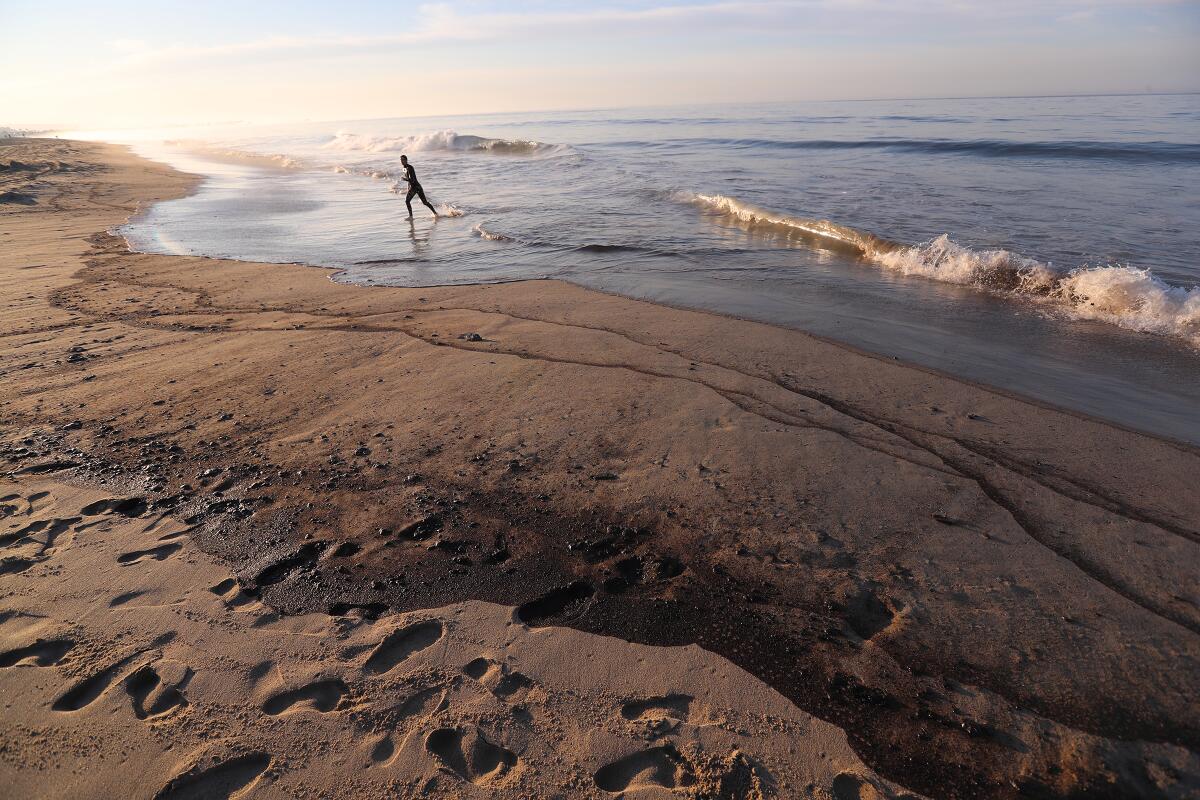
- Share via
Crews raced to contain a major oil spill off the Orange County coast as the leading edge of a miles-wide slick rolled onshore at Huntington Beach, leaving striations of crude on long stretches of sand, killing fish and birds and threatening ecologically sensitive wetlands.
The spill, first reported Saturday morning, originated from a pipeline running from the Port of Long Beach to an offshore oil platform known as Elly. The failure caused roughly 130,000 gallons of oil to gush into the Catalina Channel, creating a slick that spanned about 8,320 acres — larger than the size of Santa Monica.
Officials said Sunday afternoon that it appeared the pipeline had stopped leaking, but it was unclear what caused the spill and how long oil had been flowing out of the system.
Currents in the area Sunday afternoon were moving southeast into the waters off Newport Beach. Officials expect the oil to continue washing up onshore over the next several days.
Lifeguards closed 5 ½ miles of sand from Seapoint Street near the Bolsa Chica wetlands to the Newport Beach city line at the Santa Ana River jetty, and Dr. Clayton Chau, Orange County’s health officer, issued a health advisory cautioning people contaminated by the oil to seek medical attention. Sunday night, Laguna Beach closed city beaches, with projections showing the spill reaching Crystal Cove by 10 p.m.
Huntington Beach canceled the third and final day of the Pacific Airshow, which reportedly drew half a million visitors Friday and Saturday.
“In a year that has been filled with incredibly challenging issues, this oil spill constitutes one of the most devastating situations that our community has dealt with in decades,” said Huntington Beach Mayor Kim Carr. “We are doing everything in our power to protect the health and safety of our residents, our visitors and our natural habitats.”
The time it took to determine the scope of the leak has sparked questions from residents and others about how the early hours of the crisis were handled.
At the south edge of the city, chunks of oil floated into Talbert Marsh, a 25-acre ecological reserve for fish and shorebirds. Workers stopped much of the incursion by closing the tidal inlet with sand berms. They used floating booms to protect other wildlife areas such as the Bolsa Chica Ecological Reserve.
“We can get this cleaned up sooner and better than in prior oil spills, but that doesn’t mean it’s OK that this happened,” said Orange County Supervisor Katrina Foley, whose district includes Huntington Beach. “Someone has to be held accountable for how this happened.”
Out on the beach early Sunday, Foley watched as softball-size clumps of oil washed up onto the sand.
“It’s a huge environmental impact, and it’s an economic impact both in terms of the cleanup and shutting down a major tourist destination during a pandemic when we’ve all been struggling,” she said. “It’s a tragedy on all fronts.”
A massive oil spill off the Orange County coast has fouled beaches and killed birds and marine life
Foley urged people to stay away from the beach. She said that she could “feel the vapor” in the air and that her throat started to hurt as she walked along the beach to assess the damage.
Still, residents ventured out to see for themselves.
“It’s terrible,” said Jon Ely, a 58-year-old Huntington Beach resident. “This stuff is not going to come up. It’s goo, and it’s thick.”
As the tide was falling around noon, it left lines of oily residue across the concrete embankment of the Santa Ana River, where large fish hugged the river bottom and hundreds of juveniles swam just below the oil slick. The black globs that had pushed their way into the inlet Sunday morning were emptying back into the ocean.
The oil spill had reached the Talbert Marsh and some environmentally sensitive wetlands areas by Sunday morning.
“The smell is awful. I thought maybe they were paving my neighborhood this morning,” said Jessie Wilmoth, 24, who lives in nearby Newport Shores. Walking by the river, Wilmoth noticed the light refracting on its surface. “It looks like gas,” she said. “It’s insane. Really, really sad.”
At the river mouth, Mike Ruby, a Manhattan Beach resident, paddled out on his surfboard. When the waves lifted him, dark globs of oil were visible in the water column.
“It’s not too bad out there. There’s a light oil film on the water,” he said after coming out of the water. “But I’m not seeing too many chunks.”
He said he could taste the oil mixing with the saltwater as he surfed, and he was worried more about the wildlife.
He hadn’t noticed the black flecks of oil on his chest and back until a reporter pointed them out.
Orange County Supervisor Katrina Foley said a broken pipeline connected to an offshore oil platform called Elly caused the spill.
The California Department of Fish and Wildlife asked people not to approach or touch potentially affected wildlife, as “they can cause more harm than good to the animals.” The agency urged people instead to call the UC Davis Oiled Wildlife Care Network at (877) 823-6926, said spokesman Eric Laughlin. A crew from the network has been mobilized for any needed rescue and rehabilitation work.
The spill renewed perennial calls to end the offshore drilling along the Southern California coast, a contentious issue ever since a blowout of a drilling rig spilled 4.2 million gallons of crude off Santa Barbara in 1969. That spill helped spark the modern environmental movement and turned California into a leader in restricting oil operations in coastal waters.
Rep. Alan Lowenthal (D-Long Beach), whose district includes parts of Orange County, said the spill is “as tragic as it was preventable.”
“This environmental catastrophe highlights the simple fact that where you drill, you spill,” he said in a statement. “This will be devastating not only to our marine wildlife and ecosystem, but also to the livelihoods of our coastal communities which are built around fishing, tourism, and recreation.”
On Sunday, Rep. Michelle Steel (R-Seal Beach) sent a letter to President Biden requesting a major disaster declaration for Orange County, which would make additional federal assistance available for state and local agencies and individuals affected by the disaster.
The oil had already killed or poisoned untold numbers of birds, fish and mammals, despoiling their habitat for perhaps years to come.
“It is imperative that the federal government assist in recovery efforts,” she wrote.
Huntington State Beach is home to a number of bird species, including gulls, willets, elegant terns and reddish egrets, which are a rarity on the West Coast, said Ben Smith, a biologist and environmental consultant for the county.
Smith drove to the beach Sunday morning to observe wildlife ahead of a construction project planned at the mouth of the Santa Ana River.
“There’s tar everywhere,” he said as he surveyed the birds congregated on the north bank of the river. “You think by now we would have figured out how to keep this kind of thing from happening, but I guess not.”
The spill could have significant consequences for the habitat, he said.
“If the birds get into this tar, it’s going to stick to their feathers and it’s going to be a problem for them,” he said. “It contaminated the water — it’s bad for the wildlife, bad for the water, bad for the people who use the water.”
Areas just offshore from the Southern California coast are a major source of oil. The platform Elly, located in federal waters about nine miles off Huntington Beach, was installed in 1980 and processes crude oil production from two other platforms. They tap a large reservoir of crude oil called the Beta Field and sit in waters overseen by the U.S. Department of the Interior.
Elly is one of 23 oil and gas platforms installed in federal waters off the coast, according to the Interior Department’s Bureau of Ocean Energy Management. Besides Elly, which is a processing facility, there are 20 others that produce oil and gas, and two are being decommissioned.
Elly is one of three platforms operated by Beta Operating Co., which also operates the platforms Ellen and Eureka nearby. Elly processes oil production from Ellen and Eureka, and Elly is connected by a platform to Ellen.
On Saturday morning, workers for Houston-based Amplify Energy Corp., which owns the platform, noticed a sheen in the water while doing a line inspection and notified the Coast Guard, Amplify Chief Executive Martyn Willsher said during a news conference Sunday.
It is not clear how big the line break was, nor when it occurred. The U.S. Coast Guard said it received an initial report about 9:10 a.m., miles to the southeast of the platform off Newport Beach. Huntington Beach city officials said they were notified of the spill about the same time.
Workers moved to shut down the pipeline and use pressurized equipment to retrieve as much oil as possible soon after the incident was reported, said Kate Conrad of Beta Offshore, a Southern California oil producer involved in the operation.
“We were alerted quickly,” she said.
The environmental damage is just beginning to be assessed.
The Pacific Marine Mammal Center in Laguna Beach is preparing to triage oiled wildlife in the coming days, said Krysta Higuchi, public and community relations manager for the center.
“We’re not entirely sure of the magnitude just yet,” she said. “It’s definitely an all hands on deck kind of situation. We are trained for it, but it’s training you never want to have to use.”
She said most of the animals affected so far were birds.
“We usually see the marine mammals a couple of days to a couple of weeks after an event,” Higuchi said.
The Pacific Marine Mammal Center will be doing intake and triage on seals and sea lions. Whales or dolphins will be transported to Sea World in San Diego because that facility has bigger tanks.
“This is definitely going to be a very large cleanup,” Higuchi said.
Newport Beach Mayor Brad Avery was sailing from Avalon to the air show about 11:30 a.m. Saturday when he came across the spill. Other boaters had reported it on the marine radio as they passed over the slick, he said.
“As we got within about five miles of the coastline, all of the sudden we were going through this major oil slick,” he said. “We had a pod of dolphins on our bow as we were going through it. Of course we couldn’t signal to them to change direction, but they seemed to make it through OK.”
Officials in Newport Beach received reports of oil hitting the beach between 52nd Street and the jetty, but it did not appear to be as widespread as the oil washing up in their neighboring city of Huntington Beach.
Residents surveying Newport Beach on Sunday morning expressed skepticism about the timeline of the spill and the notifications they received.
Neal Shehab, a 61-year-old resident of Newport Shores, said he started to smell oil fumes as early as Friday night.
“We didn’t know what it was,” he said, adding that he believes the public wasn’t quickly notified because “they didn’t want to cancel the air show.”
On Saturday, the second day of the air show proceeded. Residents posted on social media, wondering whether the foul smell was a byproduct of exhaust from overhead planes.
The event is thought to generate about $68.1 million in spending and $3.4 million in additional tourism-related revenue, according to a 2019 report on the show’s economic impacts.
Hal Lopez came to town from the San Francisco Bay Area to catch the show, staying with relatives in Huntington Beach. Jogging along the packed boardwalk Friday evening, he remembers smelling something rotten — like old meat.
“I didn’t know what was going on and had to stop running. I have a very sensitive nose,” he said.
The gardener said that over dinner, his cousin told him that neighbors were talking about an oil spill. They went online to search for information to confirm or dispel rumors.
“Everyone was wondering about the local officials giving us a clue or some type of warning,” he said.
The incident comes more than 30 years after the last big oil spill along the Orange County coast.
On the afternoon of Feb. 7, 1990, the oil tanker American Trader ran over its anchor in relatively shallow water off Huntington Beach and spilled nearly 417,000 gallons of crude, fouling beaches and killing about 3,400 birds.
In 2015, an oil pipeline ruptured north of Santa Barbara and sent 143,000 gallons of crude oil flowing onto Refugio State Beach, with some of it seeping into the ocean. Tar balls from the leak were found as far as Manhattan Beach.
That spill forced the closure of Refugio and El Capitan state beaches and covered waves, rocky shores, sandy beaches and kelp forests with oil. According to the Oiled Wildlife Care Network, which was involved in recovery efforts, 204 birds and 106 marine mammals died as a result of the spill.
A Santa Barbara County grand jury later indicted Plains All American Pipeline on 46 criminal counts, including four felony charges of knowingly discharging a pollutant into state waters. The company agreed to pay more than $60 million and change its operations to settle litigation arising from the spill.
There has been debate in recent years about whether the government should allow new oil drilling off the California coast. No new offshore oil drilling has been approved in federal waters off the state since 1984.
Oil and gas production on state tidelands has more or less been declining ever since. In 1994, the state Legislature passed the California Coastal Sanctuary Act, which prohibits new leasing in state waters. As for oil operations in federal waters, governors across party lines, the State Lands Commission and the California Coastal Commission have fought off additional offshore drilling over the decades — challenging federal efforts in court when necessary.
When the Reagan administration sought to open much of the nation’s outer continental shelves, for example, 24 cities and counties across California passed laws banning new infrastructure that would support offshore drilling. Seventeen were sued by oil companies, but the local ordinances all still exist in some form today.
And when the Trump administration in 2018 pushed to open federal waters to drilling on an unprecedented scale, California — along with New Jersey, Delaware, New Hampshire and other coastal states — passed laws prohibiting new oil and gas pipeline and other infrastructure from being built on state lands. It was an attempt to make transporting oil prohibitively expensive.
Sen. Dianne Feinstein (D-Calif.) proposed a bill in January that would permanently ban the Department of the Interior from allowing new leases for the exploration, development or production of oil or natural gas off the coast of California, Oregon and Washington state.
“This oil spill is a tragic reminder that offshore drilling is a devastating threat to our coast and its wildlife,” said Miyoko Sakashita, director of the Center for Biological Diversity’s Oceans program. “I’ve seen the aging oil platforms off Huntington Beach up close, and I know it’s past time to decommission these time bombs. Even after fines and criminal charges, the oil industry is still spilling and leaking into California’s coastal waters because these companies just aren’t capable of operating safely.”
Times staff writers Hannah Fry, Jaclyn Cosgrove, Connor Sheets, Adam Elmharek, Dakota Smith, Teresa Watanabe, Robert J. Lopez, Rong-Gong Lin II, Rosanna Xia and Sean Greene contributed to this report.
More to Read
Sign up for Essential California
The most important California stories and recommendations in your inbox every morning.
You may occasionally receive promotional content from the Los Angeles Times.
